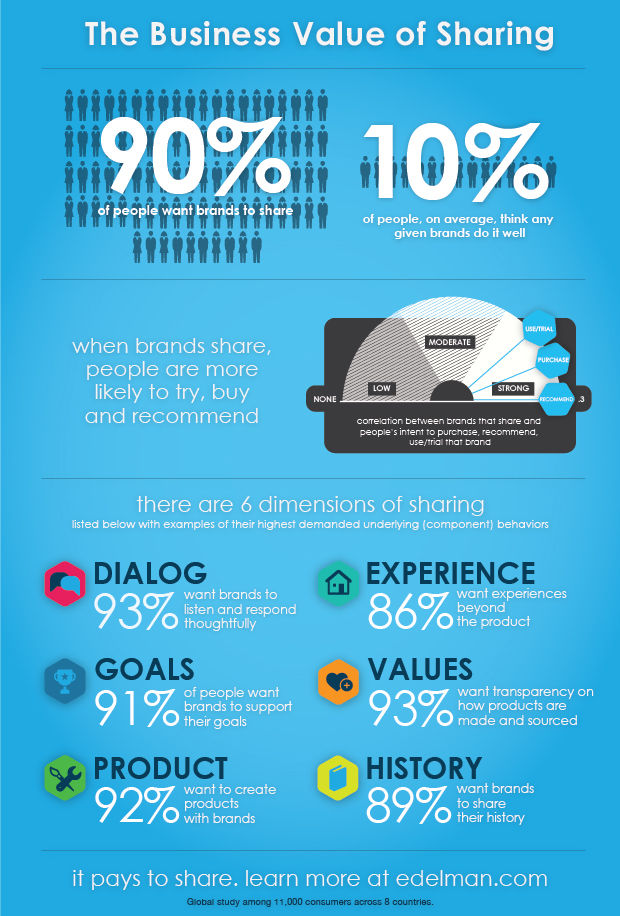Incite Group is now Reuters Events - LEARN MORE
By adaptive - January 8th, 2014

Corporations know that in order to develop universal brand advocacy, the content they create has to be shared.
Surveying 11,000 people across eight countries revealed that marketers want their brands to be shared more effectively. The research also reinforced the view that content has to be relevant if high levels of sharing are to be measured. Edelman calls this the ‘six dimensions of sharing’ that break down as:
1. Shared dialog
Do we want to talk to brands? As long as brands act on what they hear.
People are ready to offer suggestions, voice opinions and ask questions. To enable this, brands must listen and respond thoughtfully to what they hear. Brands often believe they are having a shared dialog; people often disagree. Shared dialog is the entry point to a shared relationship.
2. Shared experience
Can we do things together? If brands make every occasion meaningful.
People enjoy experiences beyond just using a product, and like being connected through real life and online activities. People in developing markets are more eager for and place a higher value on shared experiences. In developed markets, where brand experiences are no longer inherently novel, brands must recast experiences to be more about people’s interests than their own.
3. Shared goals
Do we want to achieve the same things? Just lend me your ear and a ladder.
People want brands to help them reach their goals. But goals are personal, and people would rather be asked what they need before being told how to get there. This is especially true in product categories where people aren’t always confident in their knowledge, such as financial services and technology.
4. Shared values
Do we believe in the same things? We do when brands stand up for what they stand for.
People reward brands that openly share their values. Nearly 50 percent surveyed want more transparency about sourcing, and more than 40 percent want to see more local community giving. Many brands have sophisticated values initiatives in place, but too often people aren’t seeing them.
5. Shared product
Can we create together? If brands give, they’ll get.
One of the greatest opportunities for brands lies in their willingness to let consumers see behind the curtain and participate in the product development process – we found that nine out of 10 people want to be involved. People also want complete transparency about product performance and want brands to share information about how they compare against their competitors.
6. Shared history
Do we know your story? Where brands come from shapes where they’re going.
A brand’s history is secretly seductive. It personalizes and humanizes a brand. People don’t explicitly demand that brands share their history, but a brand heritage is one of the most powerful predictors of people’s intent to purchase or recommend a brand.
Of the six sharing dimensions, shared values have the highest unmet demand among people. More than nine in 10 (92%) respondents across the eight countries surveyed – U.S., UK, France, Germany, Canada, Brazil, China and India – want to do business with brands that share their beliefs. In addition, nearly half of the respondents (47%) want brands to be more transparent about how products are sourced and manufactured, just over four in 10 (43%) want brands to do more to give back to their communities.
The key to successfully sharing a brand experience with people is to make sure the experience is as much about people’s interests as it is about the products. Shared brand experiences are in high demand among both emerging market (87%) and developed market (82%) respondents. Yet, a much larger percentage of emerging markets respondents (60%) believe that shared experience is more important in the relationship between consumer and brand than their developed market counterparts (18%) do.
“We now know more about how brands should be engaging with consumers and they must focus on a multi-disciplinary marketing approach,” said Alan VanderMolen, president and CEO, global practices, Edelman and vice chairman, DJE Holdings. “Marketers must evolve from a traditional linear model of focus groups that ends with the consumer to one that involves people at every stage. Brands must also synchronize their brand marketing and corporate communications narrative into one cohesive message, while redesigning current engagement channels to incorporate higher-value sharing.”
For brands the ability to leverage their messages must mean more intelligent and comprehensive communication of brand values. A closer connection with brand advocates delivers more personal relationships that begin with the marketing team that is often tasked with handling an organisation’s social media marketing.
What is clear is that content wants to be shared. Marketers within corporations that have perhaps focused too tightly on the creation of the content itself, and not necessarily how this content will be shared, now need to add easy sharing mechanisms to their social media communications. Placing these messages within well-crafted content is a recipe for successful brand expansion and appreciation.



